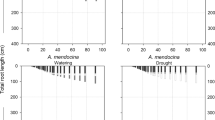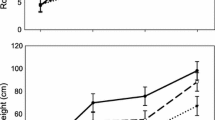Summary
-
1.
Leptadenia pyrotechnica (Forsk.) Decne. is a leafless tree growing under, adverse arid conditions in the valleys of the Eastern Desert in Egypt.
-
2.
The plant cover in areas inhabited by this species is very low and amounts to only 1% in some localities. In such an open vegetation competition between roots is lacking and each root system monopolizes a huge volume of soil.
-
3.
The root system of a small Leptadenia bush penetrates to a depth of 11.5 m and has a lateral extension of 10 m. The root system exploits about 850 m3 of soil. The distribution of the roots and their branching is closely related to the availability of the soil moisture in the different strata.
-
4.
The available soil moisture is not uniform throughout the whole profile. Depending on the average available soil moisture at the different depths, the total available moisture in the soil volume occupied by the root system of Leptadenia bush is found to be about 23000 kg.
-
5.
The annual water output by the studied bush is found to be 5700 kg. This means that the available water in the soil occupied by the root system is sufficient to supply the plant for a period of four years without replenishment by rainfall.
-
6.
The present study shows that the plant can live safely for several years under the severe conditions of the desert. The plant possesses some characteristics which help it to keep its water balance positive through increased absorption.
Similar content being viewed by others
References
Abdel Rahman, A.A., Batanouny, K.H.: Vegetation and root distribution in the different microhabitats in wadi Hof. Bull. Inst. du Désert d'Egypte 15, 55–66 (1964).
Abdel Rahman, A.A., Batanouny, K.H.: The water output of the desert vegetation in the different microhabitats in wadi Hoff. J. Ecol. 53, 138–145 (1965).
Addoms, R.M.: Enterance of water into suberized roots of trees. Plant. Physiol. 21, 109–111 (1946).
Albertson, F.W.: Ecology of mixed Priarie in West Central Kansas. Ecol. Monog. 7, 481–547 (1937).
Albertson, F.W., Weaver, J.E.: Injury and death on recovery of trees in Prairie climate. Ecol. Monog. 15, 393–433 (1945).
Cannon, W.A.: The root habit of desert plants. Carnegie Inst. Washington Publ. 131, 1–96 (1911).
Cook, C.W.: A study of the roots of Bromus inermis in relation to drought resistance. Ecol. 24, 169–181 (1943).
Gardner, W.R.: Factors governing the pattern of water utilization in a plant root zone. Arid Zone Research No. 16. Water relationships in arid and semi-arid conditions. Proc. Madrid Symp. UNESCO, p. 93-97 (1962).
Kassas, M., Zahran, M.A.: Studies on the ecology of the Red Sea coastal land. I. The district of Gebel Ataqa and El-Galala El-Bahariya. Bull. Soc. Géog. d'Egypte 35, 129–175 (1962).
Kausch, W.: Saugkraft und Wassernachleitung im Boden als physiologische Faktoren unter besonderer Berücksichtigung des Tensiometers. Planta (Berl.) 45, 217–263 (1955).
Kramer, P.J.: Absorption of water through suberized roots of trees. Plant. Physiol. 21, 37–41 (1946).
Kramer, P.J.: Roots as absorbing organs. In: Encyclopedia of plant physiology, ed. by W. Ruhland, vol. III, p. 188–214. Berlin-Göttingen-Heidelberg: Springer 1956.
Lemée, G.: L'économie de l'eau chez quelques Graminées vivaces du Sahara septentrional. Vegetation 5–6, 539–541 (1954).
Migahid, A.M.: The drought resistance of Egyptian desert plants. Arid Zone Research No. 16. Plant-water relationships in arid and semi-arid conditions. Proc. Madrid Symp. UNESCO, p. 213–233 (1962).
Migahid, A.M., Abdel Wahab, A.M., Batanouny, K.H.: Eco-physiological studies on desert plants. VII. Water relations of Leptadenia pyrotechnica (Forsk.) Decne. growing in the Egyptian desert. Oecologia (Berl.) 10, 79–91 (1972).
Oppenheimer, H.R.: Adaptation to drought: Xerophytism. Arid Zone Research No. 15. Plant-water relationships in arid and semi-arid conditions. Review of Research. UNESCO, p. 105–138 (1960).
Stocker, O.: Der Wasserhaushalt ägyptischer Wüsten- und Salz-Pflanzen, 200 p. Jena: Fischer 1928.
Stocker, O., Kausch, W.: Bodenfeuchte und Tensiometermessung. Ber. dtsch. Wetter-Dienst. US-Zone 32, 15–18 (1952).
Weaver, J.E.: The ecological relation of roots. Carnegie Inst. Washington Publ. 286 (1919).
Weaver, J.E.: Classification of root system of forbs of grassland and consideration of their significance. Ecol. 39, 393–401 (1958).
Zohary, M.: Plant life in Palestine, Israel and Jordan, 262 p. New York: The Roland Press Co. 1962.
Author information
Authors and Affiliations
Rights and permissions
About this article
Cite this article
Batanouny, K., Abdel Wahab, A. Eco-physiological studies on desert plants. Oecologia 11, 151–161 (1973). https://doi.org/10.1007/BF00345129
Received:
Issue Date:
DOI: https://doi.org/10.1007/BF00345129




